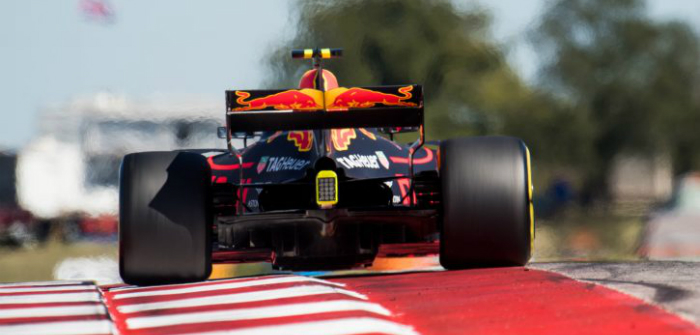There’s already been much contention and debate this week, following the US GP. Max Verstappen’s last gasp over (or under) take of Kimi Raikkonen, on the penultimate corner of the last lap was inspired, no doubt. In the spirit of the wording? Arguable, certainly. Legal? ‘Fraid not. And lets face it, it’s not the first time a white line has caused such a furore in sport…
Watching live, and in the moment, Verstappen’s overtake was the move of the grand prix; timed to perfection, capitalizing on an opportunity for the podium to top off a healthy double-figured overtake charge from the back of the grid. Superb stuff that the sport has been missing for some time. But following the initial reply my second thought was ‘offt, that’s an ambitious line’, as the onboard camera showed the car clattered over the inside kerbing with some vigour.
Exterior images confirmed the car firmly had all four wheels over one of the several lines painted on the tracks edge. The fact that Verstappen’s car was still on a solid surface, with another white line to his right remains a point of contention to myself, personally. But what is deemed the circuit by the FIA is governed by a clear set of rules. And those rules apply to everyone, except for when they don’t, which again is all explained in various written and verbal rulings by the FIA.

The issue I have with this, is the seeming pandemonium on social media and amongst viewers and fans caused by ‘gray’ areas in the wording of regulations. The outwardly lax approach to track limits at all other times of the race weekend being the major point of debate this time around. The disparity between other examples of drivers abusing the racing line, and Verstappen’s five-second penalty is clearly a confusing and contentious issue to the casual viewer. Seeing a car with all four wheels off go on to set, and retain, pole position as well as see the lead change on the opening lap under the same circumstances didn’t exactly set a precedent. Getting bogged down in the nuances of the rulings, such as the lenience on the opening lap for such an occurrence, or that the stewards had spoken with the drivers and ok’d it at certain corners at certain points complicates what is already a complicated sport. And like most forms of entertainment; if it needs explaining, then it isn’t fun.
I also take umbridge with the wording itself. Verstappen’s penalty was upheld as the stewards believed that he ‘gained a lasting advantage’. Hamilton, for example, was all four wheels off during qualifying. To me the .240s advantage he had over Vettel as the flag dropped, which incidentally gave him pole, is also a lasting advantage – is it not?
If Formula 1 is truly after a larger, and therefore, more general viewing audience then the disparity has to be addressed. The problem is how. Modern safety standards have evolved to a point where mistakes aren’t punished, and overly ambitious lines aren’t punished. Having such a wide run off, on the inside of a corner, with clearly ample room for a car to fit in to, invites racing drivers to take advantage; it’s what they’re paid to do.

Whilst I’m not for a second suggesting an about turn on circuit design (it is that way because people far more intelligent than I have worked out a lot of math) what I am suggesting is a carte blanche ruling across the board. Street circuits don’t offer the same levels of leniency for the simple reason that the run off isn’t there to take advantage of. The primary function of a run off is to protect in the event of an accident, and that should be its sole reason; they replaced gravel traps, they didn’t extend the circuit.
On a semi-related tangent, I was one of many drivers slapped with a time penalty for exceeding track limits in the last race of my season in a Caterham. The incident occurred at the shorter Silverstone ‘International’ loop, in similar(ish) circumstances to what happened at COTA. The International circuit of Silverstone’s various configurations leaves the newer infield section stage right at turn 4, cuts through the rather bumpy ‘Link’ section, and rejoins at Chapel. Carrying speed on to the Hanger Straight was critical mid-pack, so overly ambitious lines were, admittedly, being taken. And why? Because the circuit’s design at that section makes it exceptionally wide as it’s where the full GP circuit re-joins, just after the Maggots, Becketts complex – and in going wider, you took an extra 3 or 4mph to the end of the straight.
And that’s the point; drivers at all levels will take advantage of tarmac if it’s there. The difference, oddly, being that the lower levels seem far hotter on the topic than the leniencies allowed to televised events. I’ve even been in driver briefings where it’s been asked whether the club or BTCC track limits were in force that weekend…
So was Verstappen’s penalty fair? Absolutely; if taken in the context of previous rulings. Romain Grosjean was slapped with a similar punishment for exceeding track limits at Hungary in 2012, under arguably much harsher circumstance. It also strikes me as odd that whilst the stewards are keen to enforce track limits, the continued forcing of a car to less than a width from the track’s edge continues unabated; particularly through tighter sections. As a result of this, the inconsistencies will carry on as confusing to casual viewers. And because each and all of those people have access to social media and an opinion to voice, the argument is going to rumble on long past Mexico…



